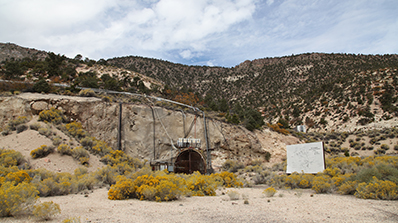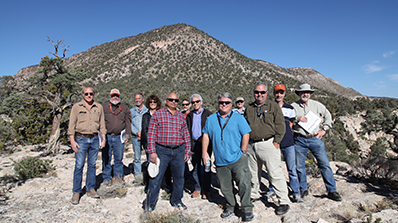Scientists in the Environmental Management (EM) Nevada Program continue to make progress in groundwater characterization, which contributes to the EM mission of protecting human health and the environment from the effects of historic underground nuclear testing at the Nevada National Security Site (NNSS). Studies at Rainier Mesa and Shoshone Mountain on the NNSS have shown minimal movement of contaminants away from the nuclear test sites, and these findings will be reviewed by a panel of independent experts in an important step toward long-term monitoring.
Long-term monitoring is the final phase outlined in Federal Facility Agreement & Consent Order (FFACO), an agreement between the Department of Energy (DOE) and the State of Nevada that outlines a schedule of commitments for remediating sites contaminated by historic nuclear testing. Long-term monitoring at the NNSS will ensure the public water supply is safe in perpetuity.
For groundwater characterization purposes, the NNSS is divided into several regions according to common attributes, such as geology and location. Characterization of these areas involves investigating the subsurface environment, creating computer models using data collected from groundwater well sampling, and measuring contaminant levels and movement within the groundwater. Once investigations have led to a comprehensive understanding of the subsurface, the supporting data for each groundwater characterization area undergoes an external peer review, in which a group of independent experts will review and evaluate whether the work being done is both scientifically accurate and ensures that it is protective of human health and the environment.

In the northern part of the NNSS, Rainier Mesa and Shoshone Mountain make up one such area. After studies and characterization were completed for Rainier Mesa and Shoshone Mountain, NDEP reviewed and concurred on the sufficiency of data. This paved the way for the external peer review process which began in October. Once the external peer review validates EM Nevada Program findings, the area will enter into long-term monitoring.
The peer review panel that will be evaluating EM Nevada Program’s work at Rainier Mesa and Shoshone Mountain consists of four experts selected from a pool of 22 qualified applicants. The peer reviewers have backgrounds in geology, hydrogeology, and environmental cleanup and regulation. Together, they have the extensive experience and knowledge required to thoroughly examine the technical reports written by EM Nevada Program scientists, while bringing an important outside perspective to the project.
Beginning in January 2018, the peer reviewers will review the associated modeling reports, as well as background information on activities conducted since the EM Nevada Program began characterizing the area in 1991. The panel will meet with EM Nevada Program scientists and managers several times as they perform their review and are anticipated to provide a final report of their findings in June 2018. Once published to the DOE Office of Scientific and Technical Information, a link to the report will be made available to the public.

“The external peer review process is important because it provides an extra layer of validation as we move through the FFACO strategy. The panelists selected are extremely competent and knowledgeable in their fields, and will be an excellent resource for the EM Nevada Program as we move Rainier Mesa and Shoshone Mountain toward long-term monitoring,” said Bill Wilborn, Underground Test Area Activity Lead for the EM Nevada Program.
The peer review kicked off on October 17 with a meeting at the Frank H. Rogers Science and Technology Building, where EM Nevada Program scientists shared their latest findings. Over the next two days, the peer review panel toured the NNSS to get a first-hand view of the geology of the site. The peer reviewers were also shown the tunnels where tests had occurred, as they received briefings on the geology specific to the area and how the tunnel configuration may affect contaminant movement within the subsurface environment.
The peer review process is a key step for ensuring public water supplies remain safe for generations to come. By using sound, defensible scientific studies, EM Nevada Program scientists and those in the external peer review panel are fulfilling the mission to protect the public and the environment from access to groundwater contaminated by historic underground nuclear testing.

